Offres de Thèses, Stages et Post-docs
Rechercher...
nombre d'offres : 125
(pourvue) Développement d’un micro-capteur piézoélectrique à nanofils de ZnO pour la mesure du frottement pariétal dans les écoulements hydrodynamiques
Date de début : 01/10/2025
Offre n° CROMA-CMNE-14-05-2025
Thèse de doctorat 2025-2028 au CROMA et LEGI
Développement d’un micro-capteur piézoélectrique à nanofils de ZnO
pour la mesure du frottement pariétal dans les écoulements hydrodynamiques
Sujet détaillé :
Dans le domaine de la mécanique des fluides, les aérodynamiciens sont demandeurs de technologies de capteur disruptives permettant la métrologie des écoulements aérodynamiques ou hydrodynamiques. En effet, la complexité des équations de Navier-Stokes rend nécessaire la complémentarité entre expériences et simulations. Comprendre les écoulements pour en prévoir le comportement et les contrôler est un enjeu majeur dans ce domaine. Plus précisément, une des deux grandeurs d’importance dans les équations de la mécanique des fluides est le frottement pariétal (force tangentielle à la surface d’un objet lors d’une interaction fluide/objet), l’autre étant la pression pariétale [1]
Le consortium pluridisciplinaire de ce sujet de thèse rapproche le CROMA (C. Ghouila-Houri, G. Ardila), le LEGI (S. Hoerner, P-L. Delafin), le LMGP (V. Consonni) et le G2ELab (L. Gimeno), autour du développement d’une nouvelle technologie de micro-capteurs de frottement pariétal, exploitant des nanomatériaux (nanofils de ZnO) et permettant des mesures en milieux liquides (écoulements hydrodynamiques).
Contexte applicatif :
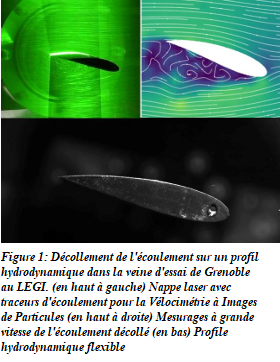 Le contrôle de l’écoulement au niveau des pales est un sujet important dans les domaines des turbomachines et de l’aéronautique. Dans le présent projet, nous nous intéressons à une problématique système liée aux turbines hydrocinétiques à axe vertical pour lesquelles contrôler l’écoulement permettrait non seulement une amélioration des performances mais également de leur durée de vie [2-4]. Plus précisément, le phénomène hydrodynamique à contrôler est le décollement de la couche limite sur les pales de turbines : l’écoulement ne suit plus la géométrie du profil de la pale mais s’en détache avec l’apparition d’une zone de recirculation (en forme d’un tourbillon) directement au-dessus de la surface de la pale. Le contrôle de l’écoulement sur un profil d’aile au moyen d’une modification active de sa géométrie (morphing) peut permettre d’éviter le décrochage et ainsi améliorer les performances d’une turbine, par exemple (voir Fig. 1). Afin d’avoir un mécanisme de contrôle automatique en boucle fermée, il est nécessaire de détecter le décollement de la couche limite et son évolution le long de la surface du profil. Dans ce but, ce sujet de thèse vise à développer un capteur d’épaisseur très faible (afin de ne pas perturber l’écoulement autour du profil). Ce capteur doit permettre de détecter le niveau du frottement pariétal et notamment le signe (positif ou négatif) donc la direction de ce frottement, afin de permettre l’identification du point de décollement.
Le contrôle de l’écoulement au niveau des pales est un sujet important dans les domaines des turbomachines et de l’aéronautique. Dans le présent projet, nous nous intéressons à une problématique système liée aux turbines hydrocinétiques à axe vertical pour lesquelles contrôler l’écoulement permettrait non seulement une amélioration des performances mais également de leur durée de vie [2-4]. Plus précisément, le phénomène hydrodynamique à contrôler est le décollement de la couche limite sur les pales de turbines : l’écoulement ne suit plus la géométrie du profil de la pale mais s’en détache avec l’apparition d’une zone de recirculation (en forme d’un tourbillon) directement au-dessus de la surface de la pale. Le contrôle de l’écoulement sur un profil d’aile au moyen d’une modification active de sa géométrie (morphing) peut permettre d’éviter le décrochage et ainsi améliorer les performances d’une turbine, par exemple (voir Fig. 1). Afin d’avoir un mécanisme de contrôle automatique en boucle fermée, il est nécessaire de détecter le décollement de la couche limite et son évolution le long de la surface du profil. Dans ce but, ce sujet de thèse vise à développer un capteur d’épaisseur très faible (afin de ne pas perturber l’écoulement autour du profil). Ce capteur doit permettre de détecter le niveau du frottement pariétal et notamment le signe (positif ou négatif) donc la direction de ce frottement, afin de permettre l’identification du point de décollement.
Contexte technologique :
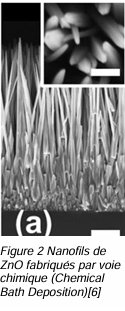 Les dispositifs piézoélectriques suscitent un intérêt croissant en tant que capteurs via l’effet piézoélectrique direct. Toutefois, les meilleures performances sont obtenues avec des matériaux dont le niveau de toxicité les rend soit compliqués à gérer soit interdits à utiliser pour des applications concrètes (par exemple le PZT contenant du plomb). Les travaux menés à CROMA dans un contexte de recherche collaboratif avec le LMGP visent à étudier des nanocomposites piézoélectriques exploitant des nanofils semi-conducteurs verticaux afin d’obtenir, grâce à la nanostructuration, des performances piézoélectriques élevées couplées à une plus grande flexibilité et des conditions de fabrication moins sévères (croissance basse température) [5-7]. L’intérêt de tels développement réside, entre autres, dans la capacité à exploiter ces matériaux pour réaliser de nouveaux concepts de capteurs.
Les dispositifs piézoélectriques suscitent un intérêt croissant en tant que capteurs via l’effet piézoélectrique direct. Toutefois, les meilleures performances sont obtenues avec des matériaux dont le niveau de toxicité les rend soit compliqués à gérer soit interdits à utiliser pour des applications concrètes (par exemple le PZT contenant du plomb). Les travaux menés à CROMA dans un contexte de recherche collaboratif avec le LMGP visent à étudier des nanocomposites piézoélectriques exploitant des nanofils semi-conducteurs verticaux afin d’obtenir, grâce à la nanostructuration, des performances piézoélectriques élevées couplées à une plus grande flexibilité et des conditions de fabrication moins sévères (croissance basse température) [5-7]. L’intérêt de tels développement réside, entre autres, dans la capacité à exploiter ces matériaux pour réaliser de nouveaux concepts de capteurs.
Les nanofils présentent généralement un diamètre de plusieurs dizaines de nanomètres et une longueur d’environ un micromètre (voir Fig. 2). Grâce à cette géométrie, ils présentent généralement une excellente qualité cristalline et bénéficient de propriétés physiques remarquables liées à leur rapport surface/volume élevé. L’oxyde de zinc (ZnO), semi-conducteur, biocompatible et composé d’éléments abondants, présente notamment de nombreux atouts et peut être fabriqué sous forme de nanofils par un grand nombre de techniques de dépôt. Grâce à sa structure cristalline wurtzite, les nanofils de ZnO se développent le long de l’axe c piézoélectrique. Les réseaux de nanofils de ZnO alignés verticalement sont donc sensibles aux contraintes mécaniques et sont susceptibles d’être intégrés dans des nanocomposites piézoélectriques visant à détecter et quantifier le frottement pariétal en mécanique des fluides.
Objectif de la thèse :
L’objectif de cette thèse de doctorat est ainsi de concevoir, fabriquer et caractériser un capteur miniaturisé piézoélectrique à base de nanofils de ZnO permettant une mesure directe du frottement pariétal, en écoulement hydrodynamique et sur maquette.
Pour atteindre cet objectif l’étudiant participera à : i) la conception et design à partir de simulations multiphysiques en se basant sur le savoir-faire dans le consortium de laboratoires (CROMA) [8-9], ii) le développement de procédés pour la fabrication et l’intégration de nanofils de ZnO via les différentes plateformes de salle blanche et de croissance à Grenoble (CROMA, LMGP, CIME, PTA) [6], iii) la caractérisation électrique, électromécanique et éventuellement de l’AFM (CROMA) [7][10], iv) Finalement Il/elle participera aux essais en écoulements hydrodynamiques (LEGI/CROMA) [2-3]. Le but sera de contrôler l’écoulement autour d’un profil hydrodynamique en le déformant (morphing) à l’aide d’actionneurs piézoélectriques et de fermer le circuit de régulation grâce au retour d’information du capteur développé dans le cadre de la thèse.
Le doctorant travaillera en équipe avec des étudiants de Master notamment pour le développement du packaging du dispositif puis l’instrumentation (G2ELAB/CROMA), en collaboration avec des étudiants en thèse qui se focalisent sur le développent des nanofils de ZnO (CROMA/LMGP) et enfin en collaboration avec des doctorants du LEGI pour mettre le capteur en application concrète dans le tunnel hydrodynamique (LEGI).
Références
[1] Schlichting, H. & Gersten, K., Boundary-Layer Theory, Springer Berlin, (2019), /10.1007/978-3-642-85829-1
[2] Hoerner, S., et al. Experiments in Fluids 62, 104 (2021). 10.1007/s00348-021-03186-8
[3] Abbaszadeh, S., Hoerner, S., et al, IET Renewable Power Generation,13, 16 (2019). 10.1049/iet-rpg.2019.0309
[4] Delafin, P.-L., et al Energies. 14. 667. (2021) 10.3390/en14030667.
[5] Bui Q C, Ardila G, et al., Mater. Adv. 3 498–513, 2022
[6] Manrique M, Consonni V, Ardila G et al., Nano Trends. 9 100066, 2025
[7] Jalabert T, Pusty M, Mouis M and Ardila G., Nanotechnology 34 115402, 2023
[8] A. J. Lopez Garcia, M. Mouis, T. Jalabert, A. Cresti, G. Ardila, Journal of Physics D: Applied Physics 56 125301 2023. DOI 10.1088/1361-6463/acbc86
[9] J. Lopez Garcia, M. Mouis, V. Consonni and G. Ardila. Nanomaterials, vol. 11(4), p.941 2021. https://doi.org/10.3390/nano11040941
[10] Parmar M, Leon Perez E A A, Ardila G, et al 2019 Nano Energy 56 859–67
Localisation
Le (la) candidat (e) travaillera dans l’équipe Micro Nano Electronics Devices (CMNE) du Centre de radiofréquences, d’optique et de micro-nanoélectronique des Alpes (CROMA) et dans l’équipe à Énergétique du Laboratoire des Écoulements Géophysiques et Industriels (LEGI). Il/Elle travaillera en collaboration avec l’équipe Nanomatériaux et Hétérostructures Avancées (NanoMAT) du Laboratoire de Génie Physique et Matériaux (LMGP).
Liens internet: https://croma.grenoble-inp.fr/, http://www.lmgp.grenoble-inp.fr/ , http://www.legi.grenoble-inp.fr
Profil et compétences requises :
Le (la) candidat (e) doit être un étudiant en école d’ingénieur ou en Master 2 dans les domaines de l’électronique, des nanosciences et/ou de la physique des semi-conducteurs ou micro/nano systèmes ou similaire. Il est souhaitable que le candidat ait des connaissances dans un ou plusieurs de ces domaines : physique des semi-conducteurs, simulation par éléments finis, microscopie à force atomique (AFM), techniques de salle blanche et caractérisations associées (SEM, etc.). Des connaissances en mécanique et en mécanique des fluides seront un atout. Les notes et le rang obtenus en licence et surtout en master constituent un critère de sélection très important pour l’école doctorale. Des compétences spécifiques en matière de travail en équipe et d’expression orale et écrite en anglais seront appréciées. Nous recherchons des candidats dynamiques et très motivés.
Financement de la thèse de doctorat:
Le financement est disponible via le pôle PEM (2025 – 2028) regroupant le CROMA, le LMGP, le G2ELAB et le LEGI dans la région grenobloise.
Contacts
Dr. Gustavo ARDILA (CROMA) Tel : 04.56.52.95.32
Dr. Cécile GHOUILA-HOURI (CROMA)
Dr. Stefan HOERNER (LEGI) Tel : 04.76.82.50.35

- Mots clés : Sciences pour l'ingénieur, Electronique et microélectronique - Optoélectronique, CROMA, FMNT
- Laboratoire : CROMA / FMNT
- Code CEA : CROMA-CMNE-14-05-2025
- Contact : gustavo.ardila@univ-grenoble-alpes.fr
- Merci de votre intérêt, mais cette offre de Thèses est déjà pourvue.
(pourvue) Design de guides d’ondes millimétriques dans un milieu poreux pour la réalisation de capteurs biomédicaux à détection électrique
Date de début : 01/10/2025
Offre n° CROMA-DHREAMS-05-05-2025
 ECOLE DOCTORALE EEATS
ECOLE DOCTORALE EEATS
Electronique, Electrotechnique, Automatique, Traitement du Signal
Proposition de sujet de thèse à pourvoir avec un contrat doctoral
Pour l’année 2025-2026
(* information à renseigner obligatoirement)
Titre de la thèse :
Design de guides d’ondes millimétriques dans un milieu poreux pour la réalisation de capteurs biomédicaux à détection électrique
Spécialité de la thèse : OR
Laboratoire d’accueil : CROMA et Université catholique de Louvain
Date de début de la thèse : 01/10/2025
Date limite de candidature : 30/05/2025 à 23h59
********************************************************************************
Direction de thèse : VUONG Tan Phu, tan-phu.vuong@grenoble-inp.fr, 50%, DHREAMS/CROMA
Co-encadrants éventuels : RASKIN Jean-Pierre, jean-pierre.raskin@uclouvain.be, 50%, UCLouvain
********************************************************************************
Contexte et thématique de recherche :
Décrire le contexte de cette recherche au sein du laboratoire, de la communauté nationale et internationale.
Préciser s’il s’agit d’une thèse exploratrice ou d’une thèse qui se situe dans la suite d’autres thèses.
Le cas échéant, donner leurs références.
Ce travail de s’inscrira dans le cadre d’une convention de cotutelle entre l’Université catholique de Louvain et l’Université Grenoble Alpes.
L’équipe DHREAMS de CROMA – UGA possède des compétences dans le domaine de conception des circuits passifs guidés à travers des plusieurs collaborations internationales et de nombreux publications de rang A dans cette thématique. L’Université catholique de Louvain possède les technologies de microfabrication de dispositifs intégrés incluant des milieux poreux et les équipements pour caractériser les dispositifs RF jusqu’à 300 GHz. Cette proposition de thèse permettra de développer une première collaboration entre deux équipes. Elle visera de concevoir des nouveaux capteurs biomédicaux à détection électrique en utilisant les nouvelles structures guides d’ondes intégrés en milieu poreux.
Description de la problématique de recherche :
Décrire en une page la problématique de recherche et les principaux axes de travail envisagés.
Les dispositifs de diagnostic biomédical de type point-of-care (POC), tels que les autotests rapides pour la Covid-19, ont connu une forte croissance ces dernières années en raison de leur simplicité, de leur rapidité et de leur coût modéré. Ces capteurs reposent en grande majorité sur le principe des tests immunochromatographiques, également appelés lateral flow assays (LFA), où l’analyte migre passivement à travers un substrat poreux (généralement en
nitrocellulose ou en silicium poreux), jusqu’à une zone de test fonctionnalisée par des biorécepteurs.
Dans les dispositifs LFA classiques, la détection repose sur un signal optique, basé sur le phénomène de résonance plasmonique localisée généré par des nanoparticules d’or, marquant la présence de l’analyte. Si cette méthode est simple et visuellement interprétable,elle reste cependant qualitative ou semi-quantitative, ce qui limite son utilité dans descontextes nécessitant une mesure fine de la concentration de biomarqueurs.
Objectifs de la thèse :
Préciser quelques objectifs à court et moyen termes notamment en termes de valorisation.
L’objectif principal de cette thèse est de concevoir une nouvelle génération de capteurs POC quantitatifs, en remplaçant le système de lecture optique par une mesure électrique haute fréquence, via la mise en œuvre de guides d’ondes millimétriques intégrés dans un milieu poreux.
Plus précisément, la thèse vise à :
- Concevoir et dimensionner un guide d’onde électromagnétique capable de détecter avec précision la présence de nanobilles d’or marquées sur la ligne de test. Des nanobilles ferromagnétiques pourraient également être d’intérêt comme biomarqueur vu leur impact sur le champ électromagnétique local;
- Étudier et sélectionner le matériau poreux optimal (nitrocellulose, silicium poreux, etc.)
en termes de compatibilité électromagnétique (conductivité, permittivité, etc.) et
microfluidique (microstructure, taille des pores, taux de porosité, nature physico-chimique des
surfaces, etc.); - Concevoir la transition adéquate entre le canal microfluidique/guide d’ondes et les
instruments de mesure comme l’analyseur vectoriel de réseau (VNA) pour des mesures haute
fréquence; - Corréler les mesures des paramètres S (S11, S21…) avec la concentration d’analyte
présente sur la ligne de test.
Conditions scientifiques, matérielles et financières du projet de recherche :
Décrire le plus fidèlement possible les moyens technologiques et logiciels mis à disposition du doctorant.
Pour rappel : le montant brut des contrats doctoraux à compter du 1er janvier 2025 est de 2100€.
Un doctorant contractuel peut consacrer 1/6 de son temps de travail annuel à une autre activité rémunérée tels que l’enseignement ou l’expertise.
Remboursement partiel des titres de transports (domicile-travail) par l’employeur UGA
La méthodologie suivra les étapes suivantes :
- Choix du substrat : Analyse des propriétés diélectriques, microstructurales et capillaires des matériaux poreux disponibles. Ce choix conditionne l’efficacité de la propagation de l’onde électromagnétique aux fréquences millimétriques, de l’écoulement de l’analyte à tester le long du guide d’ondes qui est également le canal microfluidique et l’interaction avec les nanobilles.
- Conception électromagnétique : Utilisation de logiciels de simulation électromagnétique (ADS, HFSS, CST) pour modéliser le comportement du guide d’ondes dans le substrat choisi. Étude de la transition d’impédance et du couplage avec l’instrumentation de mesure.
- Fabrication en salle blanche à l’UCLouvain : Réalisation des prototypes de guides d’ondes intégrés dans des substrats poreux, avec contrôle de la fonctionnalisation biologique de la ligne de test.
- Caractérisation expérimentale à l’UCLouvain et l’UGA : Mesures avec un VNA pour évaluer les variations des paramètres S jusqu’à 300 GHz en fonction de la concentration de nanobilles. Les données seront croisées avec des mesures optiques de référence.
- Analyse et modélisation des résultats : Affinement des modèles électromagnétiques pour interpréter les résultats expérimentaux et proposer un modèle prédictif de concentration.
Le CROMA –UGA et l’Université catholique de Louvain mettront à disposition du doctorant leurs logiciels (CST, HFSS, ADS), la technologie du milieu poreux et les moyens de caractérisation (VNA, Générateur, Analyseur de spectres,…) pour réaliser cette étude.
Collaborations envisagées :
Si la thèse se déroule dans le cadre d’un projet de recherche (national, régional ou européen), rappeler les principaux partenaires.
Citer d’autres collaborations informelles, notamment avec un établissement étranger, et préciser que
des aides à la mobilité internationale peuvent être demandées auprès de l’UGA.
Cette thèse sera en cotutelle en quatre ans entre l’Université catholique de Louvain et l’Université Grenoble Alpes. Un complément de bourse d’une durée de deux ans est prévu par l’Université catholique de Louvain pour réaliser cette thèse en 4 ans.
Une demande des aides à la mobilité internationale sera demandée auprès de l’UGA pour aider la période de mobilité en Belgique.
Profils et Compétences recherchés :
Spécialités des Master : Disciplines principales et secondaires
Stage de recherche déjà réalisé ou en cours ?
Compétences informatiques
Capacités rédactionnelles
Niveau d’anglais technique ou conversationnel
Master 2R ou Ingénieur en Radiofréquence et/ou Microélectronique
Un stage réalisé ou en cours dans le domaine de Radiofréquence et/ou Millimétrique est souhaitable
Compétences en conception des circuits passifs RF et Millimétrique, Maitriser les logiciels de conceptions (CST, HFSS, ADS, Matlab,…), Maitriser les équipements de caractérisation RF et Millimétrique (VNA, Analyseur de spectres, générateur,…), Les connaissances de salle blanche est souhaitable
Bonnes apacités rédactionnelles des documents scientifiques (rapports, articles scientifiques,…)
La Capacité de faire les présentations en anglais est nécessaire
Pour plus amples informations sur le sujet :
Lectures recommandées, Références bibliographiques, Url de sites laboratoires, projets ANR, EU,etc.
Shiqi Ma; Massinissa Nabet; Romain Hanus; Jean-Pierre Raskin; Laurent A. Francis; Dimitri Lederer « Towards Porous SI THz Planar Waveguides in Ultra-Low-Resistivity Substrates », 2024 15th Global Symposium on Millimeter-Waves & Terahertz (GSMM), DOI: 10.1109/GSMM61775.2024.10553004.
Frédéric Parment; Anthony Ghiotto; Tan-Phu Vuong; Ludovic Carpentier; Ke Wu,
« Substrate integrated suspended line to air-filled SIW transition for high-performance millimeter-wave multilayer integration », 2017 IEEE MTT-S International Microwave Symposium (IMS)
David Martín-Sánchez; Todora Angelova; Jaime García-Rupérez, « Simultaneous
Refractive Index Sensing Using an Array of Suspended Porous Silicon Membranes », EEE SENSORSJOURNAL, VOL. 20, NO. 15, AUGUST 1, 2020.
Anatoliy Oksanych; Serhey Prytchyn; Maksim Kohdas; Oleksiy Prytchyn; Vyacheslav
Sytnik; Oksana Donskykh, “Study of Adsorption of Porous Silicon to Methane and Hydrogen”, 2024 IEEE 42nd International Conference on Electronics and Nanotechnology (ELNANO).
Contact :
La candidature se fait en ligne via le lien suivant :
https://www.adum.fr/script/candidature/index.pl?site=edeeats
Pour toute question supplémentaire concernant cette proposition :
Contact : Nom, Email, adresse et éventuellement numéro de téléphone
VUONG Tan Phu, tan-phu.vuong@grenoble-inp.fr
RASKIN Jean-Pierre, jean-pierre.raskin@uclouvain.be
- Mots clés : Electronique et microélectronique - Optoélectronique, CROMA, LMGP
- Laboratoire : CROMA / LMGP
- Code CEA : CROMA-DHREAMS-05-05-2025
- Contact : tan-phu.vuong@grenoble-inp.fr
- Merci de votre intérêt, mais cette offre de Thèses est déjà pourvue.
(pourvue) Hyper AI:Solutions Edge-AI pour la Caractérisation en Temps Réel des Matériaux en Hyperfréquence
Date de début : 01/09/2025
Offre n° CROMA-DHREAMS-10-03-2025
HyperAI :
Solutions Edge-AI pour la Caractérisation en Temps Réel des Matériaux en Hyperfréquence
Context:
The electrical characterization of materials at hyperfrequencies is essential for understanding their intrinsic electronic
structure and charge carrier dynamics. Permittivity and dielectric losses are a major concern in this field, as they directly impact signal
integrity and propagation within high-speed electronic systems. Due to the stringent requirements of advanced System-on-Chip (SoC)
and System-in-Package (SiP) technologies, in situ measurements are necessary, as manufacturing processes (ie solvent deposition,
drying, and polishing) can significantly alter the electrical properties of materials, thereby affecting the overall performance of
interconnects operating at frequencies from 8 to 20 GHz. Conventional methods typically involve two stages: first, measuring the S
parameters of the structures using a Vector Network Analyzer (VNA), followed by solving the inverse problem through back-simulation
(Houzet, 2021). The latter step is computationally intensive, often relying on simulation through finite element methods (such as Ansys
HFSS) to address our specific challenges. Conducting such instrumentation remains a significant scientific challenge, particularly due
to the high computational effort required and the lack of automation in such a method.
Integrating AI-driven instrumentation could streamline the process, reducing computational load and enhancing the efficiency
of inverse problem-solving. A new hardware design is emerging from neural networks implementation with electronic circuits, often
named edge AI. Artificial Neural Networks (ANNs) are computational models designed for real-time computing for applications such
as classification of material samples through their data characteristics. Spiking Neural Networks (SNNs), also referred to as the third
generation of ANNs, are emergent devices who effectively bridge the gap between ANNs and natural intelligence in low-power devices
(Shrestha, 2022). This enables the implementation of AI solutions in-situ, ie as close as possible to the material under test. The
implementation of SNNs is performed on neuromorphic processors such as Truenorth (DeBole, 2019), SpiNNaker (Furber, 2014), and
Loihi (Orchard, 2021). These solutions fully exploit the sparsity of events and offer remarkable efficiency. However, neuromorphic
chips cannot still be considered mainstream in the market, due to costs and availability. A low-cost, low-power solution is found on
hardware-friendly neural networks in micro-controllers such as TinyOL (Ren, 2021), TinyTL (Cai, 2020), and MCUNet (Lin, 2020).
Objective:
The main goal of HyperAI is to accurately characterize the complex permittivity of materials using edge-AI solutions for
real-time computing. This is approached through a two-stage methodology:
- a. Extraction method using transmission lines (e.g., CPW, CPWG, CPS) is employed on materials with known properties to build
a database of measurement data. By varying transmission line types on the same material, we can create a robust dataset suitable
for training a neural network, enabling automated and efficient material characterization. - b. Transform an AI model into a hardware-friendly model. Flexibility, surface area, latency, memory consumption, energyefficiency, and reliability are addressed by this study. An STM32 (B-U585I-IOT02A) and an FPGA (ICE40UP5K-B-EVN)implementation should be investigated.
Keywords:
microwave instrumentation, convolutional neural networks, edge-AI, IoT.
Project Supervision:
CROMA laboratory is represented by Pietro M. FERREIRA, Full Professor at Université de Savoie Mont Blanc,
and Gregory HOUZET, Associate Professor at Université de Savoie Mont Blanc. Prof. FERREIRA has a research interest in microwave
instrumentation, neuromorphic circuits, and ultra-low power solutions. Prof. HOUZET has a research interest in materials science,
microwaves, and applied physics. Candidate will be to the tools and scientific methods of the research topic. Practical activities and
real-world scenarios are planned, including microwave measurements, scientific writing, communication and public speaking, result
quality, time management, and research project management.
Candidate Profile:
The candidate profile required for the project is a young professional holding a master’s degree in Eletrical or
Electronics Engineering, interested in the scientific field of embedded electronics, microwave, and AI. He/She must be motivated,
passionate about research in a multidisciplinary field and an organized person using scientific methods. He/She must justify good
academic tracks in maths and applied physics; an experience in design flow; linguistic competence in English (B2 written and spoken);
linguistic competence in French is a plus.
Intellectual Property:
Being fundamental scientific research, this subject is not attached to any industrial project. Intellectual property
will be promoted through scientific communications favoring the open science policy of the French government.
Bibliography:
10.1016/j.mejo.2021.104990, 10.1109/MCAS.2022.3166331, 10.1109/MC.2019.2903009, 10.1109/JPROC.2014.2304638,
10.1109/SiPS52927.2021.00053, 10.1109/IJCNN52387.2021.9533927, https://dl.acm.org/doi/abs/10.5555/3495724.3496671,
https://dl.acm.org/doi/abs/10.5555/3495724.3496706.
- Mots clés : Sciences pour l'ingénieur, Electronique et microélectronique - Optoélectronique, CROMA, FMNT
- Laboratoire : CROMA / FMNT
- Code CEA : CROMA-DHREAMS-10-03-2025
- Contact : pietro.marisferreira@univ-smb.fr
- Merci de votre intérêt, mais cette offre de Thèses est déjà pourvue.
(pourvue) Méthodes alternatives de détection dynamique pour une nouvelle génération des capteurs biochimiques de type ISFET en graphene
Date de début : 01/10/2024
Offre n° CROMA-CMNE-31-05-2024
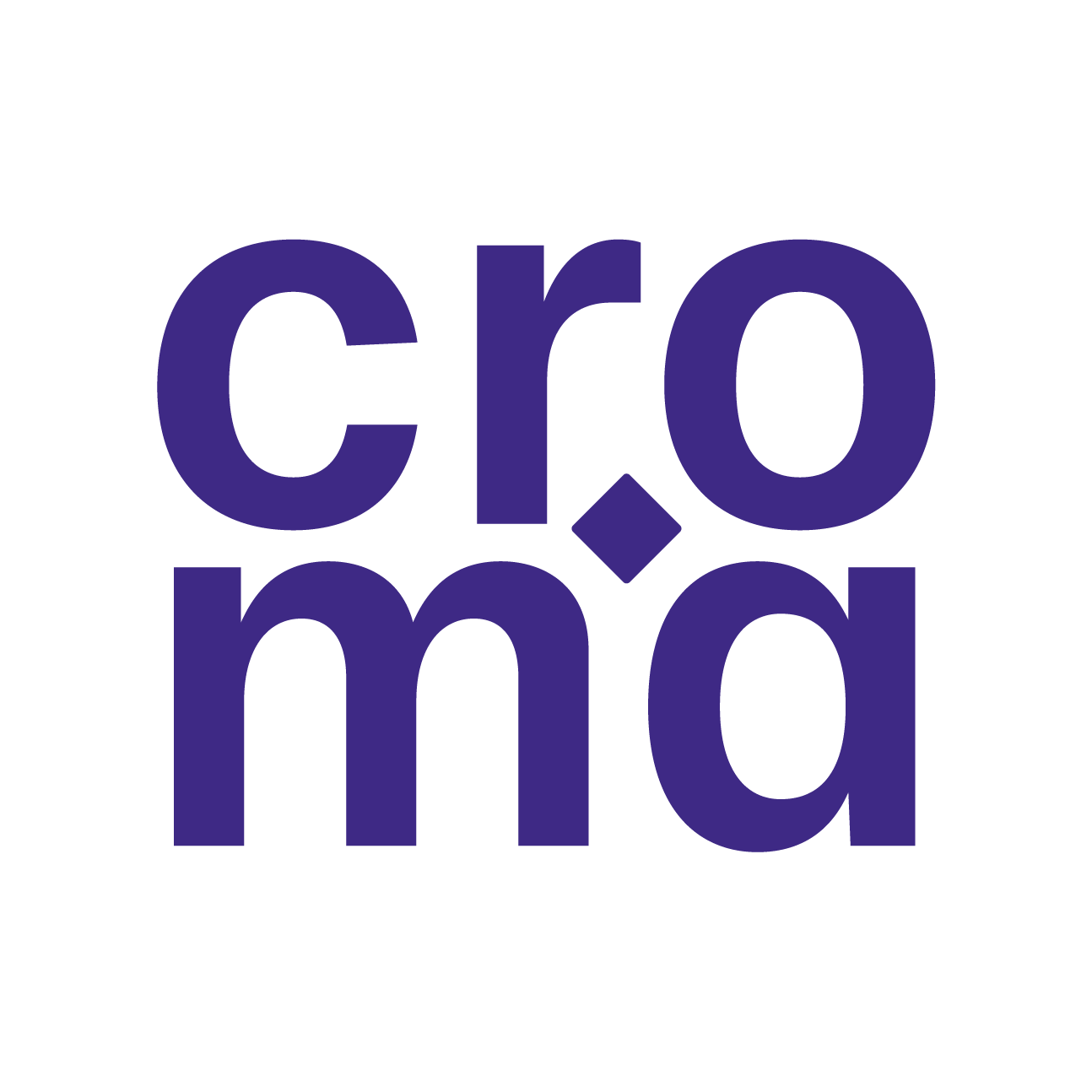 Alternative methods based on dynamic detection for a new generation of ISFET-like biosensors in graphene
Alternative methods based on dynamic detection for a new generation of ISFET-like biosensors in graphene 
Deadline for application: 18th of June 2024, beginning of contract: 1st of Oct. 2024
Place:
CROMA (Minatec) and Néel Institut, Grenoble (France)
Advisors:
Irina Ionica (Associate Professor Grenoble INP),
Cécile Delacourt (CNRS rechercher, Néel Institut),
Context and objectives:
This thesis is placed in the context of biochemical detection with ISFETs (Ion Sensing Field Effect Transistors), for which
the current which passes through the transistor channel is modulated by the presence of the charges to be detected
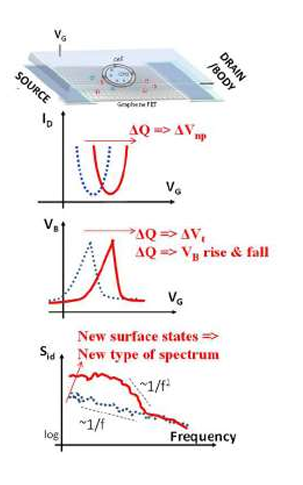 in its proximity. In the majority of cases, detection is done in real time by monitoring the drain-source current of the transistor channel.
in its proximity. In the majority of cases, detection is done in real time by monitoring the drain-source current of the transistor channel.
Quantitative measurement could be done by calibrating the drain current as a function of the gate voltage of the transistor relative to the load to be detected. This method which has already been used for many demonstrators and
applications, uses the monitoring of a quantity quasi-static (e.g. the threshold voltage of the transistor), which non-discriminatorily encompasses all type of charge contained in the solution and sufficiently close to the channel (ions, fixed charges adsorbed on the surface of the device, interface states etc).
Unfortunately, in a “non-laboratory” application, a solution does not only contain the element we wish to detect, but many others and it would be important to identify typical electrical responses associated with the constituents. Dynamic approaches, such as non-equilibrium potential or low-frequency noise, are promising because they offer, for example, the possibility of searching for specific signatures depending on the measurement frequencies.
The objective of this project is therefore not to show another demonstrator which would improve one or several
figures of merit for a given application, but rather to explore dynamic detection alternatives with an ISFET, to
study/identify the mechanisms that are responsible for the particular electrical responses of the sensor. At
CROMA, we showed that the out of equilibrium body-potential response in device fabricated on silicon-on
insulator (SOI) 1 and due to the presence of Schottky barriers at the contacts2 can be used for sensing3.
The aim of this thesis is first to implement similar methods for graphene field effect transistors and benchmark
the dynamic detection with the quasi-static and more conventional approach. At Neel, we have demonstrated
the ability to fabricate array of GFETs that offers many suitable properties for sensing living matters4 and
biochemical compounds5. Sensors manufactured on graphene will benefit from the flexibility of the technology
in order to study a wide range of options to understand the mechanisms involved and to optimize the sensors.
Modelling and simulation components will elegantly complete the project for understanding of the phenomena
and will provide keys for the optimization of future sensors.
Work do be done:
The PhD student will develop the complete chain, from device fabrication, electrical measurements in equilibrium and dynamic conditions, sensing layer and surface functionalization for specific detection applications, modeling and simulation, allowing the comprehension of physical phenomena involved
and the optimization for the sensor. To remain more generic at first, ionic solutions close to those used in cell culture media with compositions simplified (e.g.: a single type of ion) and variable concentrations will make it possible to evaluate the mechanisms and detection improvements with dynamic methods (nonequilibrium potential and/or low frequency noise). More pragmatic applications will be explored in the second half of the thesis (e.g. neuronal sensing).
1M. Alepidis, A. Bouchard, C. Delacour, M. Bawedin and I. Ionica, « Out-of-Equilibrium Body Potential Measurement on Silicon-on-Insulator
With Deposited Metal Contacts, » in IEEE Transactions on Electron Devices, vol. 67, no. 11, pp. 4582-4586, 2020
2M. Alepidis, G. Ghibaudo, M. Bawedin & I. Ionica, Origin of the Out-of-Equilibrium Body Potential In Silicon on Insulator Devices With
Metal Contacts. IEEE Electron Device Letters, 42(12), 1834-1837, 2021
3M. Alepidis, A. Bouchard, C. Delacour, M. Bawedin, & I. Ionica, Novel pH sensor based on out-of-equilibrium body potential monitored in
silicon on insulator with metal contacts. In ECS Meeting Abstracts (No. 59, p. 1589). IOP Publishing, 2021
4Dupuit, V., Terral, O., Bres, G., Claudel, A., Fernandez, B., Briançon-Marjollet, A., & Delacour, C. (2022). A multifunctional hybrid graphene
and microfluidic platform to interface topological neuron networks. Advanced Functional Materials, 32(49), 2207001.
5Terral, O., Audic, G., Claudel, A., Magnat, J., Dupont, A., Moreau, C. J., & Delacour, C. (2024). Graphene field-effect transistors for sensing
ion-channel coupled receptors: towards biohybrid nanoelectronics for chemical detection. arXiv preprint arXiv:2402.04378.
Knowledge and skills required:
The candidate must have a solid knowledge of physics of semiconductors and devices. Clean-room fabrication, electronics of measurement systems, notion of chemical physics, surface physics or electrochemistry would be appreciated to better understand the interaction at the interface with the top gate liquids. The candidate is expected to enjoy experimental work and the development of adapted measurement protocols.
Scientific curiosity, motivation, creativity, tenacity are mandatory qualities in order to take full advantage of the scientific environment of this thesis and to gain excellent expertise for his/her future career. The topic is in the field of applied physics, but close to the fundamental physics, as well as to the industrial world. After the PhD, the candidate will easily adapt to both academic and industrial research environments.
The candidate must have a very good academic record, with high grades.
For the application, send your CV, motivation l
- Mots clés : Sciences pour l'ingénieur, Electronique et microélectronique - Optoélectronique, CROMA, FMNT
- Laboratoire : CROMA / FMNT
- Code CEA : CROMA-CMNE-31-05-2024
- Contact : irina.ionica@grenoble-inp.fr
- Merci de votre intérêt, mais cette offre de Thèses est déjà pourvue.
(pourvue) Simulation, fabrication et caractérisation de transducteurs piézoélectriques transparents à base de nanofils de ZnO
Date de début : 01/10/2024
Offre n° CROMA-CMNE-28-05-2024

Simulation, fabrication et caractérisation de transducteurs piézoélectriques transparents à base de nanofils de ZnO
Sujet détaillé :
Les dispositifs piézoélectriques suscitent un intérêt croissant en tant que micro-source d’énergie en récoltant l’énergie mécanique ambiante, et en tant que capteurs via l’effet piézoélectrique direct. Dans ce contexte, les matériaux semi-conducteurs sous forme de nanofils constituent un élément de base prometteur pour la fabrication de dispositifs innovants. Les nanofils présentent généralement un diamètre de plusieurs dizaines de nanomètres et une longueur d’environ un micromètre. Grâce à cette géométrie, ils présentent généralement une excellente qualité cristalline et bénéficient de propriétés physiques remarquables liées à leur rapport surface/volume élevé. L’oxyde de zinc (ZnO), semi-conducteur biocompatible composé d’éléments abondants, présente notamment de nombreux atouts et peut être fabriqué sous forme de nanofils par un grand nombre de techniques de dépôt. Grâce à sa structure cristalline wurtzite, les nanofils de ZnO se développent le long de l’axe c piézoélectrique. Les réseaux de nanofils de ZnO alignés verticalement sont donc sensibles aux contraintes mécaniques et sont susceptibles d’être intégrés dans des nanocomposites piézoélectriques visant soit à détecter des contraintes mécaniques (par exemple, les lecteurs d’empreintes digitales), soit à récolter avec une bonne efficacité l’énergie mécanique dans l’environnement et donc à jouer le rôle d’une micro-source d’énergie.
L’objectif de cette thèse de doctorat est d’explorer théoriquement et expérimentalement l’amélioration des performances des réseaux à haute densité de nanofils de ZnO de taille ultime sur un substrat transparent (par exemple le verre) recouvert d’une électrode conductrice transparente (AZO, etc.). Des nanofils de ZnO de dimensions et de propriétés contrôlées (états de surface, dopage) seront développés à l’aide d’une technique de dépôt chimique à faible coût et à basse température, ayant un faible impact sur l’environnement et un potentiel industriel élevé. L’intégration dans des dispositifs sera réalisée sur la base du savoir-faire du consortium de laboratoires. Des techniques de caractérisation complémentaires avancées seront utilisées au niveau des dispositifs et des nanofils : des montages fait maison seront utilisés au niveau des dispositifs. Des plates-formes AFM complémentaires (SSRM, SCM, TUNA, SMIM, etc.) seront utilisées pour caractériser les nanofils individuels. Toutes ces données expérimentales (géométrie, dopage, états de surface) nous aideront à construire et à valider une plateforme de simulation à la fois au niveau du nanofil unique et du dispositif. La plateforme de simulation fournira des directives d’optimisation pour les futurs capteurs et dispositifs de récupération d’énergie.
Références:
- M. Parmar et al. Nano Energy 56 859-867 (2019). DOI: ttps://doi.org/10.1016/j.nanoen.2018.11.088
- S. Lee et al. Adv. Funct. Mater. 24 1163-1168 (2014). DOI: https://doi-org.gaelnomade-2.grenet.fr/10.1002/adfm.201301971
- J. Villafuerte et al, Nano Energy 114 108599 (2023), https://www.sciencedirect.com/science/article/abs/pii/S2211285523004366
- T. Jalabert et al. Nanotechnology 34 115402 (2023). DOI 10.1088/1361-6528/acac35
- R. Tao et al., Adv. Electron. Mater. 4(1) 1700299 (2018). DOI: 10.1002/aelm.20170029
- A. Lopez et al, Nanomaterials 11(4) 941 (2021). https://doi.org/10.3390/nano11040941
- A. Lopez et al., Journal of Physics D: Applied Physics 56 125301 (2023). DOI 10.1088/1361-6463/acbc86
- C. Lausecker et al. Inorganic Chemistry 60 (3) 1612-1623 (2021) https://doi-org.sid2nomade-2.grenet.fr/10.1021/acs.inorgchem.0c03086
- Q. C. Bui et al., ACS Appl. Mater. Interfaces 12 (26) 29583–29593 (2020) https://doi-org.sid2nomade-1.grenet.fr/10.1021/acsami.0c04112
- M. Manrique et al., Energy Technol. 2301381 (2024), https://onlinelibrary.wiley.com/doi/10.1002/ente.202301381
Localisation
Le candidat travaillera dans l’équipe Micro Nano Electronics Devices (CMNE) du Centre de radiofréquences, d’optique et de micro-nanoélectronique des Alpes (CROMA), dans l’équipe Nanomatériaux et Hétérostructures Avancées (NanoMAT) du Laboratoire de Génie Physique et Matériaux (LMGP), dans l’équipe PROSPECT du LTM et dans l’équipe Plateforme de Nanocaractérisation (PFNC) du CEA-LETI.
Liens internet:
https://croma.grenoble-inp.fr/,
http://www.lmgp.grenoble-inp.fr/ ,
https://ltm.univ-grenoble-alpes.fr/,
https://ltm.univ-grenoble-alpes.fr/research,
https://www.leti-cea.fr/cea-tech/leti/Pages/recherche-appliquee/infrastructures-de-recherche/plateforme-nanocaracterisation.aspx
Profil et compétences requises :
Le (la) candidat (e) doit être un étudiant en école d’ingénieur ou en Master 2 dans les domaines de l’électronique, des nanosciences et/ou de la physique des semi-conducteurs. Il est souhaitable que le candidat ait des connaissances dans un ou plusieurs de ces domaines : physique des semi-conducteurs, simulation par éléments finis, microscopie à force atomique (AFM), techniques de salle blanche et caractérisations associées (SEM, etc.). Les notes et le rang obtenus en licence et surtout en master constituent un critère de sélection très important pour l’école doctorale. Des compétences spécifiques en matière de travail en équipe et d’expression orale et écrite en anglais seront appréciées. Nous recherchons des candidats dynamiques et très motivés.
Financement de la thèse de doctorat: Le financement est disponible via le LABEX Microélectronique (2024 – 2027) regroupant le CROMA, le LMGP, le LTM, et le CEA-LETI dans la région grenobloise..
Contacts
Dr. Gustavo ARDILA gustavo.ardila@univ-grenoble-alpes.fr Tel : 04.56.52.95.32
Dr. Vincent CONSONNI vincent.consonni@grenoble-inp.fr Tel : 04.56.52.93.58
Dr. Bassem SALEM bassem.salem@cea.fr Tel : 04.38.78.24.55
Dr. Gwenael LE RHUN gwenael.le-rhun@cea.fr Tel : 04.38.78.12.29
- Mots clés : Sciences pour l'ingénieur, Electronique et microélectronique - Optoélectronique, CROMA, FMNT, Leti, LMGP, LTM
- Laboratoire : CROMA / FMNT / Leti / LMGP / LTM
- Code CEA : CROMA-CMNE-28-05-2024
- Contact : gustavo.ardila@univ-grenoble-alpes.fr
- Merci de votre intérêt, mais cette offre de Thèses est déjà pourvue.



 Contactez-nous
Contactez-nous Plan d’accès
Plan d’accès









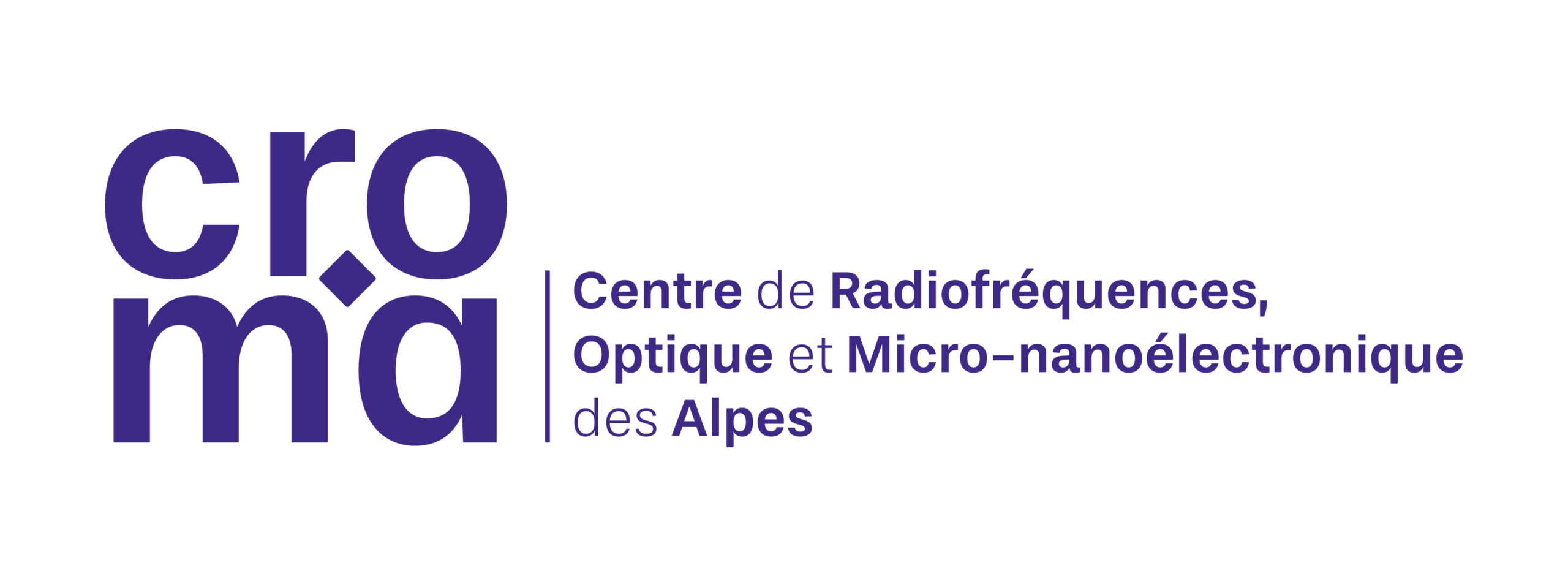
 Telecharger ma sélection
Telecharger ma sélection Réinitialiser
Réinitialiser